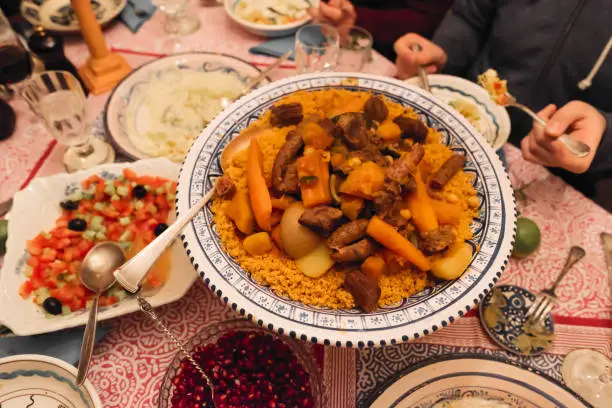Table of Contents
Here Is The List Of Top10 Best Tunisian Food & Recipes
Tunisian cuisine is a diverse blend of flavours that is reflective of the country’s history and central position in Northern Africa. Though cuisine varies across regions, Tunisian food typically incorporates French and African flavours with a spicy touch. Rooted by the country’s staple meal, couscous, Tunisian dishes often have fresh seafood or hearty lamb, depending on local availability.
Ras el hanout

Ras el hanout is a mixture that mostly contains up to 40 different spices, although some blends claim to contain more than 100 different spices. Translated, ras el hanout means the top of the store, implying that the blend of spices is the greatest and finest thing a customer can purchase from the merchants.
Overall, the mixture of spices should be aromatic, warm, sharp and slightly pungent, including some typical ingredients and some uncommon ingredients such as dried lavender, caraway, galangal, a variety of peppers, dried rosebuds and Japanese white ginger. Ras el hanout may often also include hashish or Spanish fly.
It is very versatile, and can be rubbed into meat or stirred into rice dishes, and is particularly important for giving the spicy and sweet aromas of the popular Moroccan tajines. Although each blend of spices differs and no single spice stands out of the blend, when working together, ras el hanout gives dishes amazing taste and flavour.
Kafteji
Kafteji is a popular Tunisian dish made from fried vegetables. Typical vegetables used in the dish include eggplants, bell peppers, potatoes, onions, courgettes and pumpkins. Vegetables are fried, sliced, and mixed with often fried eggs and seasonings.
The dish is sometimes sprinkled with parsley or coriander and served as a side dish for poultry or fish, although it can be eaten as it is. Kafteji is also a popular street food in Tunisia, often served in baguettes.
Harissa

Harissa is a popular spicy paste from Tunisia. This spicy paste is made with roasted red peppers as the main ingredient, as well as olive oil and spices and herbs such as cumin, coriander, caraway and garlic. There are so many variants on harissa that there is no set recipe, and every family has its version. Some people are known to add lemon juice or fermented onions to the mix. This condiment is also used in sandwiches or with couscous and goes well with meat such as beef, poultry, lamb, and goat. Harissa is also added to some soups and stews.
Fricassee
A fricassee is a traditional Tunisian sandwich filled with flavour. The base is made of flour, eggs, oil, salt, water and yeast and then shaped into round or elongated rolls, which are fried in hot oil and filled with tuna, hummus, boiled eggs, capers, olives, harissa and boiled potatoes.
Although this sandwich can be made at home, it is particularly popular in fast-food restaurants and sandwich shops.
Msemen
Msemen is a typical Moroccan flatbread made with a mixture of flour, semolina, sugar, salt, yeast, warm water, oil and pureed butter. The dough is kneaded until it is smooth, and the bits are flattened and formed into squares.
When the dough has been folded and shaped, it is cooked on a griddle or fried in a pan until it is crispy on the outside and chewy on the inside. While msemen is traditionally eaten on its own as a side dish to coffee or tea, it can also be stuffed with a variety of meats and vegetables.
Mechouia

Mechouia is a Tunisian salad made with grilled onions, peppers, tomatoes and garlic, drizzled with olive oil and seasoned with caraway, salt and black pepper. The salad is then normally garnished with hard-boiled eggs, olives or tuna. Salad may be eaten on its own, but it is also often served with toasted bread or baguette slices. It is very popular to find it in Tunisia as part of a mixture of appetizers in traditional restaurants.
Lablabi
Tunisian chickpea soup is a staple of the working class—cheap, easy to cook, packed, and commonly found in local restaurants. Lablabi is a hot and spicy dish, also very greasy and thick, usually flavoured with garlic, cumin and harissa.
Traditionally, it is served over bits of stale crusty bread, drizzled with olive oil, often with either vinegar or lemon juice or lime juice, and sometimes garnished with cilantro, parsley and scallions.
Brik
Tunisian Brik is a common dish that includes flaky dough stuffed with a variety of savoury ingredients. Traditionally, malsouqa dough is used to produce brik, but the more available phyllo pastry is widely used as a substitute. Brik is typically made from layers of laminated pastry to create a crunchy, layered texture.
The pockets are filled with stuffing, skilfully folded, and fried in deep oil or baked in the oven. The most popular filling is tuna, which is enriched with typical North African spices such as cilantro, chilli pepper or coriander.
The raw egg is always put on top of the tuna filling, the pastry is carefully folded and the egg is partially cooked inside the flaky pastry.
Shakshouka
Shakshouka is a wonderful mix of eggs poached in a spicy tomato sauce. While it has an odd name, the dish is simple and easy to produce. It is normally made in a skillet where the onions, tomatoes and spices are cooked until they form a delicious tomato sauce.
Eggs are then added directly to the tomato sauce and poached until finished. Merguez sausages may also be added to the dish. Shakshouka is thought to have originated in Tunisia, but the dish is well known and widely eaten across North Africa and the Middle East.
Couscous
Numerous small, light, tender grains, preferably arranged to form a pyramid and served on a plate at the end of a meal that is, couscous, Moroccan national dishes and must-have dishes in any Moroccan restaurant. The term itself refers to both the full dish and the tiny grains of semolina.
Semolina flour is sprinkled with water until it forms tiny pellets that are then forced through a sieve. Couscous is usually served for lunch on Fridays when entire families come together for the most important meal of the week. Traditionally, the dish is made in a metal steamer pot called a couscoussier, where the stew is on the bottom, while the small grains are in the perforated basket on the top, cooked in the steam that rises from the rich stew.








